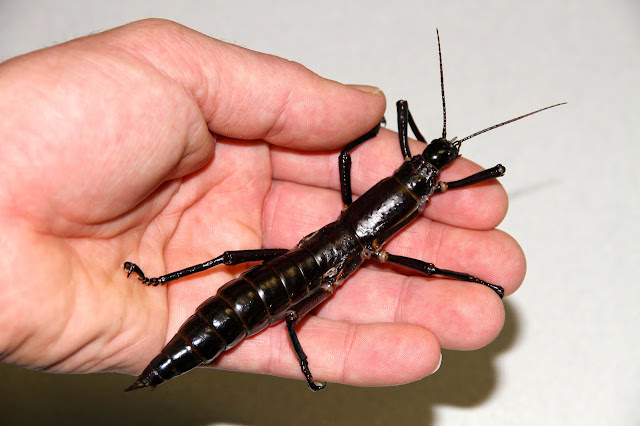·
Lord Howe Island thrush (Turdus
poliocephalus vinitinctus). A subspecies of the
island thrush, this bird was a ground-nesting species and an easy target for
the rats.
·
Lord Howe gerygone (Gerygone insularis). This
small insectivorous bird disappeared as rats raided its nests.
·
Lord Howe starling (Aplonis fusca hulliana). The
starling succumbed to competition and predation.
·
Lord Howe fantail (Rhipidura fuliginosa
cervina). A subspecies of the New Zealand fantail, it was wiped out
as the rats preyed on its eggs and chicks.
·
Robust white-eye (Zosterops strenuus). This
distinctive bird was another victim of rat predation, vanishing within a few
years of the rats’ arrival.
and now the good news, a few climbers had reported stumbling on suspicious insect remains on Ball’s Pyramid, a tall sea stack about 14 miles from Lord Howe Island, from the article:
'In 2001, two determined researchers, Dr. David Priddel and Dr. Nicholas Carlile from the NSW Government’s Office of Environment and Heritage, decided to settle the mystery once and for all.
They joined an expedition to Ball’s Pyramid, a tall sea stack about 14 miles from Lord Howe Island, where
A tiny population of living Lord Howe Island stick insects had somehow persisted there.
“We’d get requests from people saying they were going to find this stick insect,” says Carlile, “but then you’d look at the list of people and there wouldn’t be an entomologist on there!”
Not only did a few insects survive, but they also managed to multiply within a cramped, precarious habitat.
Researchers believe the survivors on Ball’s Pyramid likely benefited from the rugged environment, which had no rats.
Another factor that may have helped is a special trick called parthenogenesis, which lets female insects lay fertile eggs even without a mate.'
what a great success story, literally back from the dead, the full fascinating story of these insects is here.



No comments:
Post a Comment